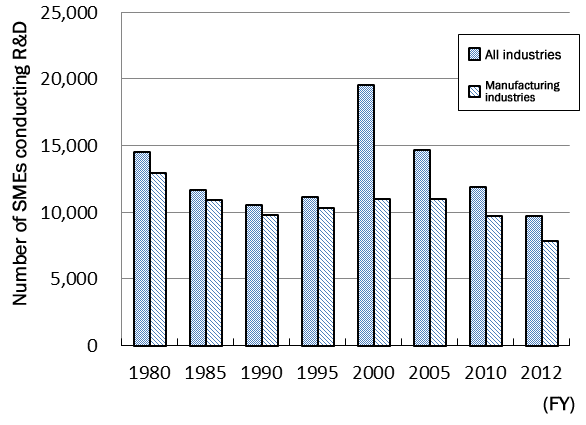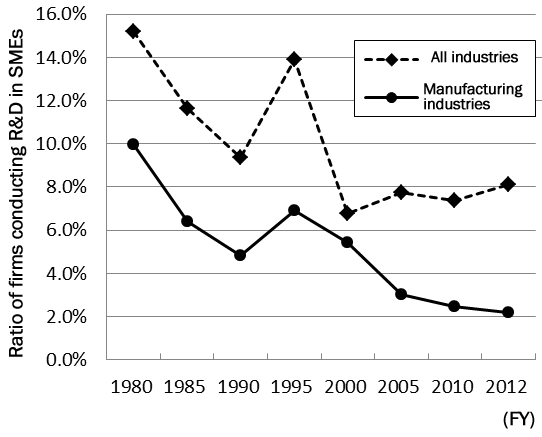Rising expectations for small and medium enterprises for promoting innovation
An increasing amount of research overseas has suggested the importance of smaller organizations such as small and medium enterprises (SMEs) in recent years. Langlois points out that for a long period beginning toward the end of the 19th century, large firms grew and big organizations were competitive thanks to economies of scale and scope, but this era came to an end toward the close of the 20th century. In the new era, he argues, smaller-scale enterprises that specialize in a certain field and partner with others through networks have become competitive (Note 1). Plenty of research on innovation indicate that SMEs are better at, for example, adopting new technologies, and have complementary relationships with larger firms (Note 2), and that SMEs become more competitive by networking with other firms or universities (Note 3). In recent research on national innovation systems, Geels insisted that existing technological systems in a society's core domains are too closely tied to the social system to be changed directly, but that new technologies are adopted in niche domains and spread out to the entire society (Note 4). The expectation for SMEs, which excel at creating niche markets, is growing (Note 5).
As an SME policy, the Japanese government considers SMEs as the source for the dynamism of the national economy, and has taken measures to encourage their research and development (R&D) proactively since the revision of the Small and Medium-sized Enterprise Basic Act in 1999. However, the government has pursued innovation policy mainly for large firms up to now, because large firms account for 94.0% of business domestic expenditure on R&D (according to the Report on the Survey of Research and Development 2012 by the Ministry of Internal Affairs and Communications). Therefore, it would be necessary to strengthen innovation system reform by taking advantage of the vitality of SMEs from now on.
The views put forward in this column are my personal opinion and not that of the organization to which I belong.
R&D by SMEs: Positive and negative points
The top management in many SMEs takes the lead in R&D as well as the production and development of sales channels. Because the top management takes responsibility of the business strategy and R&D strategy, both strategies are highly integrated, and a process to coordinate them within the company is not necessary. This allows management to take risks, to make decisions quickly, and to change course based on market reaction. As a result, SMEs are characterized by agility and flexibility (2000 White Paper on Small and Medium Enterprises in Japan), and those SMEs that conduct R&D have higher profitability (2009 White Paper on Small and Medium Enterprises in Japan).
However, the percentage of SMEs conducting R&D is not so high, and it has fallen particularly in recent years as shown in Figures 1 and 2. (Note: In these figures, "SMEs" are enterprises having one to 299 employees. "All industries" means all of the industries covered by the Report on the Survey of Research and Development except for finance and insurance.)


On the other hand, the SMEs that conduct R&D change in very rapid succession, and many firms have begun R&D in recent years. In addition, there are many firms taking advantage of the universities, such as conducting their first R&D by joining industry-academic partnerships. In these cases, the executives' positive managing attitude is suggested to be the most important factor (Note 6).
Reforming the innovation system in Japan
Gross domestic expenditure on R&D in Japan amounts to 17.3 trillion yen (3.7% of the gross domestic product), there are 836,000 researchers (according to the Report on the Survey of Research and Development 2012, Ministry of Internal Affairs and Communications), and 374,000 patent applications were filed in 2012 (Note 7). Any of these indicators is high by world standards, and financing for investment continues to be provided at low interest rates. So why is innovation in Japan considered to be not contributing so well to economic revitalization, although it has a favorable environment in all conditions of funding, human resources, and technology? What is missing from Japan's innovation system?
Perhaps it would be "entrepreneurship." In order to create new markets by innovation, we have to take risks boldly, and absolutely need entrepreneurship. A company with such spirit could obtain the technology, human resources, and funding necessary for the new business not only from inside but also from outside through a network.
Top managers of firms must possess entrepreneurship. Therefore, the role of SME owners is very important, considering the fact that SMEs account for 99.7% of the 3.86 million firms in Japan (2012) (Note 8).
Additionally, the government also has important roles in inspiring the entrepreneurship of SME owners and supporting innovation therein. A report which proposes to strengthen medium-sized firms, SMEs, and venture businesses through national R&D projects and support by the National Institute of Advanced Industrial Science and Technology (AIST) was released in June 2014 by the R&D and Evaluation Subcommittee of the Committee on Industrial Science and Technology Policy and Environment under the Industrial Structure Council. Also, the Ministry of Economy, Trade and Industry (METI) has started to tackle this issue. This policy is extremely important. Therefore, I expect the national innovation policy also to proceed in this direction, especially in the Science, Technology, and Innovation Basic Plan that will be examined in FY2015.


